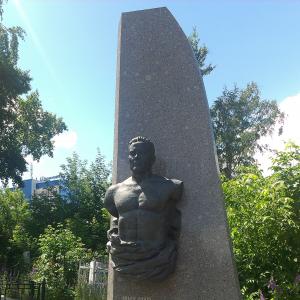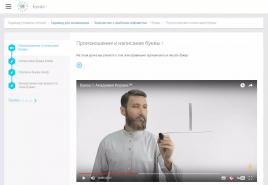How to study the material correctly in order to remember it well. Techniques for studying geographical nomenclature in preparation for the Unified State Exam Forget about rote cramming
Every person periodically faces the need to learn material of varying content and volume. This comes easily to some, but the vast majority of people face difficulties, not knowing how to quickly memorize a given amount of text.
The functioning of the human brain is still not 100% understood; we only know that we use a small part of the brain’s abilities. Psychological processes, occurring in the human mind, are amenable to daily training. Memory and other mechanisms of consciousness can be developed to unprecedented heights. A strong memory will allow you to achieve success in any area of human life; it will be needed in “everyday” life, study, and will easily improve intellectual abilities.
To learn text, artistic or scientific content, you will need constant memory training with exercises specially designed for this. Human memory is divided into visual, auditory, olfactory, gustatory and tactile. It represents the ability to remember and store any amount of information.
Each type of memory develops differently in people. Some people find it easier to remember a text by saying it out loud, while others, on the contrary, learn it better after visualizing what they read. Therefore, it is important to understand which type of memory is better developed in order to use it for memorization in the future.
The same information can be learned well in several ways. There are three ways to remember required material in a short time.
- Method of rational memorization;
It is based on the use of logical memory. In the process of rational memorization, the semantic and logical connection of the material with life experience is consolidated in the mind. With rational memorization, awareness of the text read occurs and information is more easily perceived. This method helps to remember the material by heart, trains intellectual abilities and increases knowledge.
- Method of mnemonic memorization;
This is the most interesting method of the three. It helps to remember non-semantic information by processing it into images and associative connections. Mnemonic memorization is based on acquired life experience, translating the text into images familiar to consciousness. This method helps to remember a large amount of material that does not carry a semantic load. These could be dates, phone numbers, names, addresses. It helps combat everyday forgetfulness by increasing the ability to mechanically remember things that happen.
- Method of rote memorization.
This method involves memorizing the material. It is considered ineffective and difficult to train, since it can fail at any moment, “falling out” of memory. As we age, our rote memorization ability declines.
Memorization techniques
To quickly assimilate text, different memorization techniques are used. One of the most effective method thoughtful reading. It is well suited for memorizing large and small volumes. This method is used by actors, for whom it is more important than anyone else to know how to quickly learn a text by heart.
- First, we slowly and carefully read the text that needs to be remembered. It's better to read it out loud. When reading you need to understand main idea text, its main plot, so that you can remember it faster.
- If the volume of material is large, we break it into semantic parts. Each part must be learned separately, finding the main words or phrases in them. This will help in the future to restore all the text in order.
- After this, you need to rewrite all the text manually. This must be done slowly, delving into the essence of what is written.
- After everything is rewritten, we retell what we remember. You need to remember the smallest details, based on keywords. If you can’t remember a moment, it’s better not to look at the recording, but try to do it yourself. You can only peek in as a last resort.
- Next, we rewrite a second time only what we remembered without prompting.
- At the last stage, we carefully re-read the text and retell it. It's better to do this before bed.
This memorization method is suitable for learning a text word for word. It will help students, schoolchildren and anyone who needs to know how to learn a large amount of information in a short time. Theater and film actors use this method to remember their roles.
Tricks for quick memorization
There are several other simple but very effective tricks for memorizing the entire text, based on the nuances of our brain. To do this you need:
- Highlight the main points in the text with a bright marker;
This will allow you not to be distracted by unnecessary text. Actors thus highlight their lines in the script.
- Sing words or text;
This is a non-standard method of memorization. Having sung the material, it will be better embedded in your memory and you can recall it faster.
- You need to read until the meaning becomes completely clear;
It is very important to feel feelings and emotions, if this fiction that the heroes experience.
- After reading, you need to ask yourself questions about the content;
- Read out loud with expression;
- Write the text with the other hand;
If you are left-handed, write with your right hand, if you are right-handed, write with your left. This clever trick will force your brain to spend more effort analyzing all the written material.
- Find a training partner;
The actors rehearse in pairs, this helps in their work. You can also ask someone you know to test your knowledge of all the material. Learning by heart is more interesting and much easier in a company.
- Record the text on a voice recorder;
Record the text on a recording device and listen to it throughout the day while doing your daily routine or while traveling. This will help you remember voluminous text without being distracted from other things and without wasting extra time.
Memory needs to be constantly trained. Memorizing information consists of encoding it and sending it to a special part of the brain for further storage. If the information is needed, it will be easily remembered. When it is not used for a long time, the brain will remove it as unnecessary. Forgetting is inherent in humans; it happens after a certain time. This natural mechanism brain function and it helps not to overload the brain unnecessary information and if it is not used, it disappears from memory over time.
The work of assimilating and consolidating in memory the placement of a cartographic object on a map along with its corresponding name in our methodological literature is usually called “the study of geographical nomenclature.” It usually begins with the teacher and then the students finding, showing and naming the corresponding cartographic images on the map.
The teacher faces three pedagogical tasks: 1) how to teach so that the name is correctly pronounced and firmly learned; 2) how objects should be shown; 3) how to teach how to correctly find them on the map. All three of these problems are solved together. The organization of work is based on the use of all types of memory - visual, auditory, motor and verbal-semantic.
To assimilate the name, the teacher uses various techniques - clearly pronounces the name, and in some cases writes it on the board, noting what you need to pay attention to. IN junior classes the name is repeated syllable by syllable, written down in notebooks, and immediately found and read on tabletop maps, which, in essence, does not relate to the map. The task is to associate a cartographic image of the corresponding object with the name. To do this, simultaneously with the assimilation of the name, work is carried out with the map itself.
The attention of students is drawn to the specific features of the image of an object that distinguish it from all others: its special shape, size, color, etc. For example, appliqués are often used for these purposes.
The essence of the technique is that the teacher first cuts out the outline of the objects being studied from colored paper and compares them with some figures: the Black Sea resembles a bean, the Apennine Peninsula resembles a boot, the Scandinavian Peninsula resembles the figure of a lying lion, etc.
These comparisons, although not exact, allow students to quickly locate the desired features on the map. In order to develop correct ideas about the size of the countries being studied, applications are attached to the desired places on the map or placed on the outline of other objects, with the sizes of which the areas are compared.
In order to consolidate in memory the cartographic image and its associated geographical name Many teachers, when working with a map, strive to arouse students’ interest in the object itself, for example, they report on the origin of the name, on a particular incident, interesting fact, associated with a given object, etc. Often the very name of a geographical object contains deep meaning, and its interpretation helps not only to remember the name, but also to understand its essence. Such techniques, of course, arouse interest, as a result of which the student more easily remembers not only the name, but also the cartographic image of the object.
When displaying geographical objects on a wall map, didactic rules must be followed. You need to show it with a pointer, without obscuring the drawing. You need to place the pointer on the symbol, not on the inscription; areas need to be outlined, and linear objects (roads, rivers) should be shown by moving the pointer along them in a certain direction. These rules must be taught to schoolchildren (especially in primary school).
It is not enough to learn the name and show a cartographic image of the studied object - the student needs to remember where the object is located on the map and be able to quickly find it. To do this, you should pay attention to the position occupied by the object being studied among other images surrounding it, and train students in memorizing them relative position. When searching for an object specified on a map, the student uses a known system of landmarks, along which he gradually gets to the goal.
For example, the student firmly remembers that the Mediterranean Sea should be looked for on the map between Europe and Africa; the city of Gorky stands at the confluence of the Oka and Volga. Each class should have its own system of guidelines determined by the program. In order to consolidate the skill in using a system of landmarks, it is useful to require students that, when showing an object on a map, they describe its position, starting with the most general to specific landmarks.
A very valuable technique in this sense is when the teacher forces the student to tell him how to find a given object on the map. Its value lies in the fact that students comprehend the internal logic of the definition geographical location, acquire the skills of coherent reading of cartographic text, master the correct terminology and generally develop speech and thinking. It is also important that this technique allows students to monitor the position of the described object based on a verbal description. “The correct geographical determination of a location, not only on a map, but also in words, serves as an indicator of skillful teaching of geography,” says Prof. V. P. Budanov.
Very often, to make it easier to remember a place on a map, teachers use various didactic aids— flag” and conventional icons, laces and arrows, two pointers, etc. By attaching such materials to the right places on the map during the lesson, the teacher fixes the students’ attention on certain points in order to facilitate the perception of the position of the object being studied on the map. In some cases, the same problem can be successfully solved with the help of a chalk sketch on a blackboard showing the desired object close up. These techniques also help to consolidate in memory the relative placement of geographic objects on the map.
The work of accumulating a stock of firmly acquired geographical nomenclature should not be carried out in isolation from the study of geography itself. Mechanically memorizing the position on a map of any list of geographical objects is of little use. It generates formal knowledge of the map. Experienced teachers never turn this work into rote learning or simple mechanical actions. They always strive to make such work meaningful.
For example, when studying political map In Europe in the 6th grade, during the lesson you have to remember many states and their position on the map. Students are given the task of grouping states according to their position: a) on the mainland; b) on islands and peninsulas; c) landlocked; d) facing the Baltic and North Seas; e) located on the coasts Atlantic Ocean and the Mediterranean Sea, etc.
Students are warned that when answering, they will need to show on a physical map, and that along with showing the borders, they must also name the border states. These kinds of problems require a creative approach to solve them. In them, nomenclature is only an auxiliary element. The nature of the tasks causes repeated repetition of the same state in various combinations. This ensures the strength of memorization of political divisions and contributes to the repetition of the part of the world as a whole. As a result of intelligently solving such problems, deep knowledge and the ability to accurately, as if automatically, show objects on the map are achieved. But such an automatic skill will be the result of a lot of creative work.
As you can see, the best means for mastering geographic nomenclature on a map is the map itself. In this regard, let us dwell on the characteristics of some specific methods of using a map for the purpose of teaching its knowledge, where special maps and special cartographic work are used for this. We will talk about drawing and copying maps, drawing up map diagrams and special maps, working with contour and silent maps and some other techniques.
Drawing and copying maps under the name of the “constructive method” was very widely used in the Russian school in the second half of the 19th century. The passion for it was so great that all other teaching methods receded into the background. Its essence was that students drew cartographic outlines of objects from memory, using auxiliary points and lines. This work was largely mechanical, which led to formal knowledge of the map.
At the beginning of the 20th century, a change in views on the goals of teaching geography led to an almost complete abandonment of this teaching method. In its place, school life included drawing maps and working with contour maps. However, even today, drawing maps from memory is sometimes used. It is valuable not only because it leads to lasting memorization, but also serves as a means of combating superficial examination of drawings, drawings and maps, which is so common among students, and contributes to the development of a very valuable skill - to express one’s spatial ideas with a drawing, a drawing, in general - the ability draw, draw. Therefore, of course, one should not completely abandon the method of drawing maps. Obviously, it is important to observe moderation in everything.
Drawing maps is widely used in teaching geography. Experienced teachers draw them on the board as they present new material, sometimes involving students in similar work. In other cases, students, on the instructions of the teacher, draw certain objects on the outline. Such simple map diagrams can be created in class when studying new material and at home while working on a textbook. In a number of cases, drawing maps is used when questioning students.
The advantage of a map diagram is that it reflects only the most important thing that you need to pay attention to. In addition, a map diagram is easier to draw than a regular map. Drawing is further simplified if the map diagram is drawn up on a contour map or on a previously prepared contour (a stencil is used to make such contours).
Work with contour maps pursues the same goals of consolidating and testing students’ cartographic ideas. The drawing itself is kept to a minimum here, since the cartographic outline of the country on the map is preserved. This simplifies things and makes it easy to involve all students in cartographic work. In most cases, it consists in the fact that, guided by their desk maps, students find on the contour map, mark and label the location of the desired objects, for example, find, circle and label rivers, mountains, cities, etc. These works can be very diverse in form and content - from simple drawing of the necessary objects on a contour map to creative work on the preparation of map diagrams and special content maps. There are also various forms of using these cards to test students' knowledge.
Outline maps convenient not only for drawing up schematic maps. They are convenient for carrying out cartometric work (measuring lengths, areas, directions, laying out routes, plotting points at given coordinates, etc.), work on establishing natural and artificial boundaries on the map (identifying the boundaries of a river basin, geographical landscape, administrative units, industrial districts, areas, etc.) etc.
Currently, work with contour maps is included as mandatory in all classes. The methodological literature reflects considerable experience in the diverse use of these maps in teaching. Contour maps are widely used in teaching geography in schools in the GDR, Poland, Bulgaria and other countries, where there are also interesting techniques and forms of working with them.
Silent cards are usually wall cards physical cards devoid of any inscriptions. They were widely used in school in the past to reinforce and test knowledge of geographical nomenclature.
Currently, such maps, unfortunately, are not published. Experience the best teachers showed the undoubted usefulness of using silent maps in teaching schoolchildren to understand, read and know maps. It's all about how to work with such a card, and not about the card itself. Any methodological technique can be brought to the point of absurdity if it is misapplied or abused. In the past, our school used semi-mute cards on which names were marked only with an initial letter or two or three initial letters. Find on such maps geographical features easier than on a regular dumb card. In the GDR and other foreign countries, silent cards are widely used in the educational process.
In conclusion, let us also mention the so-called duty card. This is an ordinary large-format educational wall map (usually a world map or the USSR), on which the most important current geographical events are marked with flags or icons. These signs are connected by laces with a short explanatory text attached to the edges of the card. Current life events marked on it constantly attract students' interest to the map. This helps strengthen knowledge of geographic nomenclature, develops map understanding, and strengthens map reading skills.
In general, the teacher should strive to ensure that the geographical map is in front of the students’ eyes as often as possible. For example, it is useful for a wall geographical map to constantly hang in the classroom where students are in class, so that the student also has his own map at home on the wall near his working corner (except for the atlas, which every student should have as an indispensable aid as textbook).
A useful pedagogical technique leading to an increase in cartographic knowledge, skills and abilities are a variety of games with cards, for example, cartographic lotto, dominoes, games for guessing objects by their cartographic symbols and contours, for finding objects on the map using figurative verbal descriptions of them, games - traveling on a map, etc. Unfortunately, in our methodology, the issue of using games in educational work with maps is almost completely undeveloped. Meanwhile, they could become a powerful means of increasing cartographic culture.
- Larger volume of information compared to tables;
- The presence of identical and frequently repeated numbers, for example 50, 100, 500, 1000;
- The existence of specific images in words, product names, for example.
Unfortunately, we do not have the opportunity to consider the large price list in more detail.
Therefore, we will give a small example, allowing you to understand the essence of this memorization technique.
Grill sauce - "Chumak" - Ukraine - 300 g, 12 pcs. (packed), 12.1 rub. (per unit);
Spicy soy sauce - Bamboo stalk - Russia - 300 g, 12 pcs. (packed), 16 rub. (per unit).
We present the packages of one and the other sauces and remember them in sequence using the “Cicero” method. Then we remember each horizontal sequence separately. This is what we get.
Chumak (psychic) holds Grill sauce in his hands. He is wearing a Ukrainian kosovorotka (or eating dumplings). We hang the following images on Chumak. We put a huge newt on his head (300), a diamond necklace (12) sparkles on his neck, and a long roll of tracing paper sticks out from his belt (121). It is important to note that the price can be expressed not only in whole numbers, but also in decimal fractions. Therefore, let's agree to remember decimals with one digit after the decimal point, techniques for memorizing three-digit numbers. If there are two digits after the decimal point, then we will remember in pairs, i.e. the first pair is an integer, and the second is the decimal places. Now introducing Soy Spicy Sauce hanging on a bamboo stalk. A Russian man wearing earflaps is trying to take off the sauce, but he doesn’t succeed. Then he decides to release his pet newt (300) to remove the sauce from the branch.
The sauce really fell down, and not just one, but with a shiny necklace (12). The man was very happy and began pouring sauce over the porridge (16).
Control recall is required.
Whether you're studying for a test, trying to learn a foreign language, or simply hoping to retain what you've learned in class, remembering the material can be challenging. While the brain is surprisingly good at retaining information you've studied over time, it's not always easy to recall it when needed. Use several memorization techniques to quickly recall the necessary details in your memory. Make your brain more receptive to absorbing new information by taking care of your mind and body, and working in a suitable environment.
Steps
Use memory tricks
- For example, if you are trying to remember words for a lesson foreign language, do not take more than 7-8 words at a time.
- If you are studying from a textbook, it will be useful to familiarize yourself with the structure of the book. Textbook chapters are usually divided into short sections, each of which provides a volume of information that is easy to master. Focus on understanding and remembering one section before moving on to the next.
-
Switch between different themes. To help your brain organize information more efficiently, it will be useful to switch between studying various items. Alternating between topics that are very different from each other will help your brain not get bogged down trying to remember too much information about one subject (or two very similar subjects) at a time. In addition, switching between topics will prevent you from overheating while working on one of them.
Take notes. When you listen to a lecture or read a text, write down important pieces of information. Don't write down every word you hear or read. Better take notes on the basic concepts. This forces the brain to process information and compress it into the most important elements.
Check yourself. As you study each section of the material, take breaks to check yourself. To do this, you can create flashcards, compose questions, or perform test exercises or tasks that are prescribed in the textbook. If you study with a friend, you can ask each other.
Review the material at regular intervals. When you are trying to remember something, it is important to repeat it over and over again. This method works best if you give yourself enough time between repetitions so that you don't start to forget what you've learned. Repeating information after a short period of time strains the memory muscles and helps you delve deeper into the material.
- To begin with, repeat the material at short intervals and gradually increase them. For example, if you studied something one day, sleep with this information, and the next day repeat it several times. Check yourself in a couple of days, and then again a week later.
- Try study timer apps like ClockWork Tomato or TimeOut to help you schedule your study intervals.
-
Create memory signals, so-called mnemonic devices. One of the most simple ways memory access is the creation of associations that trigger memories. To do this, you can use abbreviations (for example, KGB in reverse to remember the flag Russian Federation: red - blue - white, only in reverse), puns or wordplay, and also draw distinctive images in your mind.
Explain the material to someone else. When you try to teach someone, it helps you understand better yourself educational material. In order for you to explain something, you must understand it yourself. You must briefly describe and present the material in a way that makes it clear and understandable to the other person. This will help you absorb and assimilate the information better.
“Sleep” with this information. Most people need 7-9 hours of sleep every night to stay in good shape. Getting enough sleep not only gives you energy and helps you concentrate, but it also helps you learn and remember. Your brain processes new information while you sleep, so you may find that you understand complex concepts better after taking a nap or getting a good night's sleep. Make the most of your sleep by practicing good “sleep hygiene”:
Eat well. Eating healthy can give you the energy you need to concentrate and retain information in your head. Eat plenty of “lean” proteins (fish, lean meats and leafy greens), whole grains, fruits and vegetables, and foods with healthy fats (such as vegetable oil, fish and nuts). Drink enough water throughout the day.
Take breaks. If you try to force yourself to study for too long in one sitting, you'll soon start to nod off or your mind will start to wander. To make studying more bearable and effective, try studying one hour at a time. Take 5-15 minutes between sessions to have a snack, stretch your legs, or put your head down and take a quick nap.
Break the material into small sections. Information is easier to process and remember if you break it down into tiny pieces. Instead of trying to memorize an entire textbook chapter, focus on one short section or key information at a time.
3
Chemical nomenclature appears to be a way of "negotiating" chemistry with mathematics. But where to start? ... and what are the reasons and theories? Some "names" are taken from latin... I know there are IUPAC rules, etc., but it is so demanding and exaustive to learn all these rules at once, for organic and inorganic chemistry. Maybe there are reasons and rules that help us to name a chemical or a compound... Since I am interested in metallurgy, can you give me some tips? To connect the theory with a formula, ad strutural formula, would be good. An untouchable “why” in the universe is always welcome.
0
Welcome to Chemistry.SE. As you say, there is a lot of nomenclature, not to mention additional jargon pertaining to our techniques, methods, tools, etc. There is a reason that it is usually broken down into smaller chunks and spread throughout the entire four year degrees in chemistry. Oddly enough, the nomenclature of metals** alloys** is one of the few types that is rarely taught. - Ben Norris Oct 19 13 2013-10-19 11:58:37
1 answer
Sorting:
Activity
2
Chemical nomenclature is a mixture of historical features, empirical knowledge, and a bit of systematics. And, as you mentioned, explore everything exhaustively at once.
To understand the nomenclature, you must understand the systems themselves. Because it is their structure and reactivity that is reflected in the name.
This results in a failed circular dependency. To start learning any chemical industry, you must know its language. But without knowing science, language has no meaning. It's similar and you probably can't do anything about it, just cut that circle and go through the nomenclature. It will start to make sense once you get deep enough. Also, the “why” is a good indicator. Once you have enough knowledge to understand the answer, why it's named the way it is, you can probably answer it yourself.







